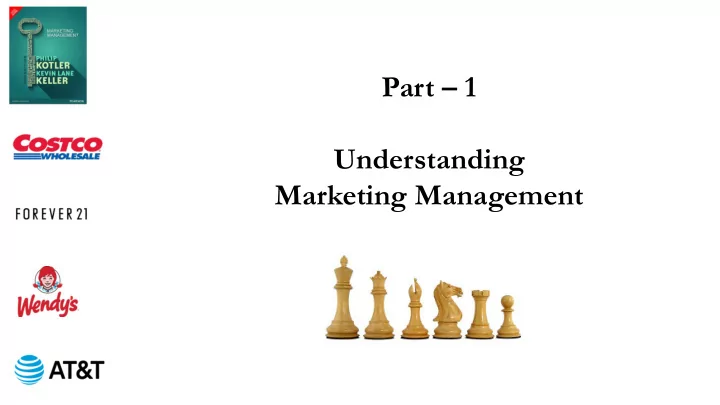

Part – 1 Understanding Marketing Management
Resource Person MATHISHA HEWAVITHARANA MBA (Col),BBA Sp.Mktng (Col), PPG DIP. In Mktng (UK), MCIM (UK), Chartered Marketer (UK), Practicing Marketer (SL), ACMA, CGMA CIMA (UK), DBF (IBSL), AIB (IBSL), MSLIM(SL), Head of Branches - Siyapatha Finance PLC
Self Introduction You Your Name Work Place Work Profile Academic & Professional Qualifications Other Details
Chapter Contents • Marketing Concept • Company Orientation towards Marketing • Macro Environmental Scanning • Micro Environmental Scanning • Porter’s Competitive Forces
What Is Marketing? Is it a Theory ? Is it a Concept ? Is it Selling Goods & Services ? Is it creating unnecessary Needs ? Is it Done by You ? 01
What Is Marketing? Marketing is the activity, set of institutions, and processes for creating, communicating, delivering, and exchanging offerings that have value for customers, clients, partners, and society at large.
What Is Marketing? Marketing is the systematic management process that is responsible for identifying, anticipating and satisfying customer needs and wants competitively, effectively and profitably in a socially acceptable manner.
What Is Marketing? Marketing is an organizational function and a set of processes for creating, communicating, and delivering value to customers and for managing customer relationships in ways that benefit the organization and its stakeholders.
What Is Marketing Management? Marketing management is the art and science of choosing target markets and getting, keeping, and growing customers through creating, delivering, and communicating superior customer value. NC 03
What Is Marketed? • Goods • Services • Events • Experiences • Places NC 04
What Is Marketed? • Persons • Properties • Organizations • Information • Ideas NC 05
Markets • Marketplace • Marketspace • Meta-Market
Demand States • Negative (Carbonated Drinks) • Nonexistent (Medicine) • Latent (Space Travelling) • Declining (Manual Camera) • Irregular (Christmas Decorations) • Full (Mobile Phones) • Overfull (Motor Cars – Alto / Quid) • Unwholesome (Alcohol / Cigarettes)
Structure of Flows in Modern Exchange Economy
A Simple Marketing System
Key Customer Markets • Consumer markets • Business markets • Global markets • Nonprofit / Government markets
Chapter Contents • Marketing Concept • Evolution of Marketing • Macro Environmental Scanning • Micro Environmental Scanning • Porter’s Competitive Forces
Evolution of Marketing
Evolution of Marketing The Production Concept The Product Concept The Selling Concept The Marketing Concept The Holistic Marketing Concept
Evolution of Marketing The Production Concept Beginning of Capitalism to Mid 1950’s Henry Ford Model “T” $ 950 NC 07
Evolution of Marketing The Production Concept
Evolution of Marketing The Product Concept 1950’s – 1960’s NC 08
Evolution of Marketing Product Concept
Evolution of Marketing The Selling Concept 1960’s – 1970’s NC 09
Evolution of Marketing Sales Concept
Evolution of Marketing The Marketing Concept NC 10
Evolution of Marketing Marketing Concept
Evolution of Marketing Holistic Marketing Concept
Evolution of Marketing Hotistic Marketing Concept
Company Ori rientations • Customer orientation • Competitor orientation
Lim imitations of f Mark rketing Concept • Difficulty in Accurate identification of real needs • Internal business capacities & constraints • Social & Environmental constrains NC 11
Marketing Environment Internal Environment External Environment - Micro environment - Macro environment
Marketing Environment Internal Environment Micro Macro NC 12
Marketing Environment - Internal Shareholders General Employees Managerial Employees Departments Structure / Policies / Culture NC 13
Chapter Contents • Marketing Concept • Evolution of Marketing • Macro Environmental Scanning • Micro Environmental Scanning • Porter’s Competitive Forces
Marketing Environment – External (Micro) Customers Distributors Intermediaries Financial Service Providers Competitors NC 14 A NC 14 B
Chapter Contents • Marketing Concept • Evolution of Marketing • Macro Environmental Scanning • Micro Environmental Scanning • Porter’s Competitive Forces
Marketing Environment – External (Macro) Political Environment Economical Environment Social & Cultural Environment Technological Environment Ecological Environment Legal Environment
Marketing Environment – External (Macro) POLITICAL ENVIRONMENT Taxation - Political Philosophies - Political Based Relationships - Political Structure / Stability -
Marketing Environment – External (Macro) ECONOMICAL ENVIRONMENT Interest Rates - Exchange Rates - Inflation - Level of Employment -
Marketing Environment – External (Macro) SOCIAL & CULTURAL ENVIRONMENT Social Perceptions - Cultural values - Religious Believes - attitudes - NC 15
Marketing Environment – External (Macro) TECHNOLOGICAL ENVIRONMENT Production Technology - Communication Technology - CRM - Data Base Management - NC 16
Marketing Environment – External (Macro) ECOLOGICAL ENVIRONMENT Green Concept - Sustainable Growth - Positive Externalities - NC 17
Marketing Environment – External (Macro) LEGAL ENVIRONMENT Incorporation - Reporting - Human Resource Management - Managing Externalities - NC 17 B
Competitors • Direct Competitors • Indirect Competitors
Chapter Contents • Marketing Concept • Evolution of Marketing • Macro Environmental Scanning • Micro Environmental Scanning • Porter’s Competitive Forces
Porter’s Competitive Forces
Porter’s Competitive Forces THREAT OF NEW ENTRANCE Sharing of Resources - Sharing of Market - Sharing of Profits - Sharing of Success - Higher the Threat of New Entrance, lesser the Industry Attractiveness would be. NC 18
Porter’s Competitive Forces BARGAINING POWER OF CUSTOMERS Delivering High Quality - Customization - Offering for the Best Price - Related & Supporting Services - Higher the bargaining Power of Customers, lesser the Industry Attractiveness would be.
Porter’s Competitive Forces BARGAINING POWER OF SUPPLIERS Quality of Input - Price of Input - Lead Time of Input - Credit terms - Higher the bargaining Power of Suppliers, lesser the Industry Attractiveness would be.
Porter’s Competitive Forces THREAT OF SUBSTITUTES Availability of Substitutes - Importance of the Original Product - Switching Cost - Higher the Threat of Substitutes, lesser the Industry Attractiveness would be.
Porter’s Competitive Forces COMPETITOR RIVALRY Number of Competitors - Capacity of Competitors - Number of Customers - Industry Regulations - Higher the Competitor Rivalry, lesser the Industry Attractiveness would be. NC 19
Review • Marketing Concept • Evolution of Marketing • Macro Environmental Scanning • Micro Environmental Scanning • Porter’s Competitive Forces
Thank You ! 0773 – 29 20 29 mathihewa@yahoo.com
Recommend
More recommend